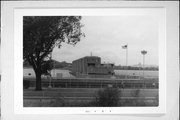Property Record
MISSISSIPPI RIVER BETWEEN WALNUT AND CEDAR STS
Architecture and History Inventory
| Historic Name: | UPPER MISSISSIPPI RIVER 9-FOOT CHANNEL, LOCK & DAM #4 |
|---|---|
| Other Name: | UPPER MISSISSIPPI LOCK AND DAM #4 |
| Contributing: | |
| Reference Number: | 2525 |
| Location (Address): | MISSISSIPPI RIVER BETWEEN WALNUT AND CEDAR STS |
|---|---|
| County: | Buffalo |
| City: | Alma |
| Township/Village: | |
| Unincorporated Community: | |
| Town: | |
| Range: | |
| Direction: | |
| Section: | |
| Quarter Section: | |
| Quarter/Quarter Section: |
| Year Built: | 1932 |
|---|---|
| Additions: | |
| Survey Date: | 1977 |
| Historic Use: | dam/lock |
| Architectural Style: | NA (unknown or not a building) |
| Structural System: | |
| Wall Material: | Concrete |
| Architect: | ARMY CORPS OF ENGINEERS |
| Other Buildings On Site: | |
| Demolished?: | No |
| Demolished Date: |
| National/State Register Listing Name: | Not listed |
|---|---|
| National Register Listing Date: | |
| State Register Listing Date: |
| Additional Information: | A 'site file' exists for this property. It contains additional information such as correspondence, newspaper clippings, or historical information. It is a public record and may be viewed in person at the Wisconsin Historical Society, State Historic Preservation Office. LOCKS ASIDE DAM AND OPERATING ROOMS ATOP DAM. HAER WI-47. Once the upper Mississippi River was capricious: fast and turbulent during floods, too shallow to navigate during dry seasons, rife with snags and shifting sandbars. Today it is a generally smooth and predictable waterway that allows for safe shipping all year round. Locks and dams made the difference. Beginning in the 1930s, the Army Corps of Engineers built twenty-nine dams on the 669-mile stretch of river between Minneapolis and St. Louis. Together, the dams turned the free-flowing upper Mississippi into a stairway-like series of slack-water navigation pools, with locks to lift or lower boats from one pool to the next. This astonishingly ambitious Nine-Foot Channel Project--so called because it ensures a minimum nine-foot depth in each pool at all times--linked North and South, boosted interstate commerce, and created thousands of jobs for unemployed workers during the Great Depression. Each lock-and-dam complex is different, not just because each section of the river is unique but also because technology advanced rapidly even as the Corps’s work progressed (see also LC08). At Lock and Dam No. 4, the first six dam gates closest to the Wisconsin side are 60 feet wide and cylindrical. These are submersible roller gates, those that can roll three feet below the surface to allow ice, debris, or floodwater to pass overhead. Formerly, nonsubmersible roller gates, which rose to allow debris and water to pass underneath, caused serious riverbed erosion. The No. 4 Dam--the Corps’s first to use submersible rollers--caused less erosion. But by the later stages of construction, in the late 1930s, even these had been superseded by the Tainter gate, which is shaped like a long section of a cylinder, with the convex side facing upstream. The gate rises or falls by pivoting on wedge-shaped rocker arms attached to it at either end. The twenty-two gates on the Minnesota end of Dam No. 4, each 35 feet wide and 15 feet high, are all Tainter gates. Today the Corps is giving each its own motor, like those of the roller gates, but originally a gasoline hoist ran from gate to gate along rails on top of the dam. Although the Corps custom-developed these gates, Jeremiah Tainter of Menomonie patented the basic design in 1886. Knapp, Stout and Company, the giant lumber firm that Jeremiah’s older brother Andrew co-owned, was the first to use them, in that case to release water from the company’s millponds. Numerous engineers and contractors created Lock and Dam No. 4. William McAlpine, a long-time Corps engineer who also worked on Bonneville Dam and the Tennessee Valley Authority, headed the design team. Engineer W. D. Fairchild oversaw construction. Treadwell Construction Company of Midland, Pennsylvania, designed the roller gates; Ouillmette Construction and Engineering Company of Chicago was general contractor for the lock; and United Construction Company, of nearby Winona, Minnesota, contracted on the dam. Despite the impressive engineering, not everyone cheered the transformation of the river into a mechanized canal. The Izaak Walton League, concerned that flooding previously dry land would harm the valley’s environment, led a protest during the design phase of Dam No. 4. The Chicago, Burlington, and Quincy Railroad joined in, charging that the dam would damage its right of way. In response to these concerns, the Corps lowered the water level of the pool by three feet, but the project still widened the river channel from 800 to 2,000 feet, inundating much of the flood plain and permanently altering the riverine ecosystem. |
|---|---|
| Bibliographic References: | Buildings of Wisconsin manuscript. |
| Wisconsin Architecture and History Inventory, State Historic Preservation Office, Wisconsin Historical Society, Madison, Wisconsin |

